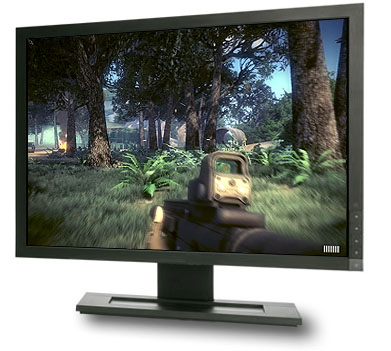
The user interface of the S2 ENGINE HD development tool has been fully programmed using the interface system of Engine itself that, in turn, is built on the rendering device.
With this system it will be easier for us, in the next future, porting the engine to other systems such as MAC-OS or LINUX.
It has also enabled us to achieve a more professional interface design and introduce new mechanisms that make the editor more usable and comfortable than the previous version.
In S2 ENGINE objects are divided into classes, each class has its unique characteristics: static meshes, particle systems, decals, characters, weapons, etc...
In the new editor there is a browser of objects.
The browser objects are configured instances of base classes of the system. Int the browser they appear as icons that contain a thumbnail image. Of course you can still create new instances, configure them and save configuration for later reuse.
This system lets you to avoid reconfiguring the objects that are already created and inserted into the scene, as it was in the old editor, making the job of level designer faster. Now you can insert a new object by dragging its browser icon directly into the scene.
Each object has parameters depending on the type of class it belongs, these parameters can be changed with a special tool.
In addition there are tools specifically dedicated to objects rotation, scaling and positioning that are among the most frequent operations in the construction of a scene.
As in previous versions in S2 ENGINE HD every object can receive and send messages, the script is then scheduled to reply to every message received.
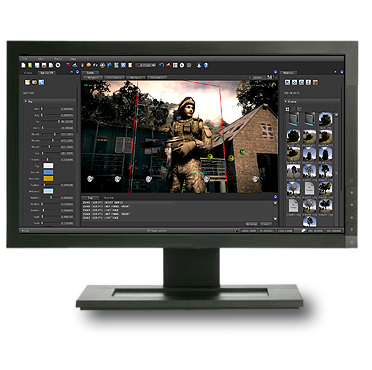
In the new editor you can directly send messages to objects by a special tool. This system is useful for debugging and testing because you can program an object response to a message and then immediately test it in the editor.
The terrain support is one of the strengths of the new editor.
All operations performed on terrain take effect immediately, in real time.
The terrain can be carved, creating mountains or valleys. In the latter case, falling beyond a certain limit you choose, you will see the emergence of water.
The carving tools allow not only terrain elevation and depression but also the smoothing and the creation of Ramps helping you to pave streets.
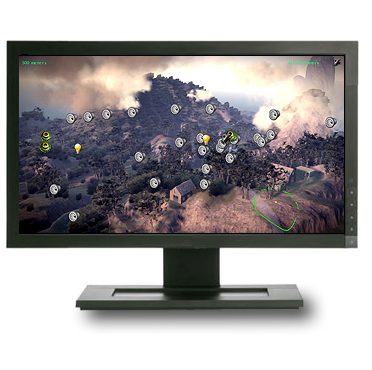
The terrain can be "painted". You can paint up to four different layers
Each layer consists of a texturemap and a normalmap and has few parameters such as its phong and fresnel reflection, mapping coordinate tiling, etc... just like in materials editing.
It is possible to paint not only textures but also sets of objects, which we call vegetation layers. This feature is useful in the creation of wide layers of vegetation.
Each level of vegetation can be composed by 4 different types of objects (trees, plants, grass) that are positioned according to certain parameters, chosen by the user, such as density, type and some random variables.
To improve the vegetation management in S2 ENGINE HD new classes of objects has been implemented. They can be composed by a set of instances of a unique mesh, eg. a plant or a stone, which is repeated a number of times in different angles and positions, each instance fit the height of the terrain.
With this system you can then create blocks of many stones, plants, clumps of grass that are managed by the engine as unique objects and then very quickly.
The last, but not least, terrain feature is the management of roads. In S2 ENGINE HD roads can be created directly on the terrain.
These are composed of segments that fit the terrain and can be rotated to form curves. You can also set the road width and material.
Due to the powerful shaders a new material creation and management system has been designed.
In the new editor you can change the parameters of a material directly selecting the object in the scene!!.
Every object, in fact, has different surfaces and every surface have a material, by selecting the object surface material is selected.
Like objects materials also have a browser. To change the material of an object surface you have only to drag the material icon from the browser to the surface, and voila you're done.
It's possible, then, with a special tool, enabling up to four levels for each material. Each level has a texturemap and a normalmap and some parameters such as diffuse color, tiling of the map coordinates, its brightness, Fresnel reflection, etc. ..
One of the most interesting features of the new system is the possibily to paint a layer on another, a bit like photoshop levels, and you can do it directly on object in the scene!!.
This allows, for example, to decorate materials with patches of dirt, rust or corrosion, always using the same texture but painted differently for different materials.
The result is a wide variety of colors achieved with a minimum waste of texture memory.

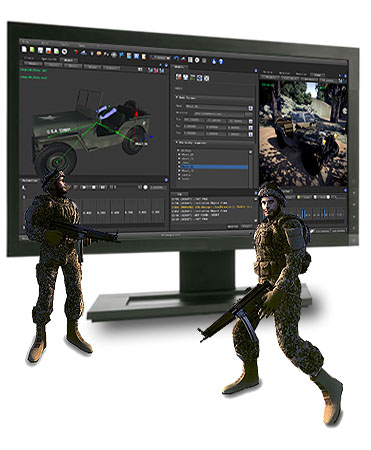
S2 ENGINE HD handles three different types of models: simple mesh, skeletal models and models with hierarchy.
The skeletal models (Skin & Bones) and models with hierarchy can be animated.
As for the materials and objects there is also a browser for models.
Each node of a model can contain an object.
With a special tool you can change the position and orientation of nodes, add new ones or delete them: This system is helpful for insert/delete, and modify dummy nodes to which attach other items such as weapons, lights, etc...
You can also set other parameters of a node such as its object material, his name, etc. ...
You can manage the animations of a model: add or delete animations, add and configure masks (see animation) add or remove keyframes, and set parameters such as speed and name.
S2 ENGINE HD has a system for managing ragdolls. In the editor you can create, remove, parameterize the capsules of each node in the model and joints that connect the physical system used for simulating ragdolls.

The simulation of night-and-day cycle is one of the main innovations of S2 ENGINE HD.
In the editor you can change a variety of parameters at any time of day: the density of the clouds, the intensity of sunlight, the fog density, the intensity of god rays, the intensity of rain, the flash frequency, the density of water and its color, the water bump and many others.
Given a latitude (from pole to equator), Every moment of one day corresponds to a location and a color of the sun.
Given a time of day the user can change these parameters until it reaches the desired result. In this case he may insert a keyframe in the cycle and leave the Engine the task to interpolate all the values with the other key frames included.
The possibilities are endless!!
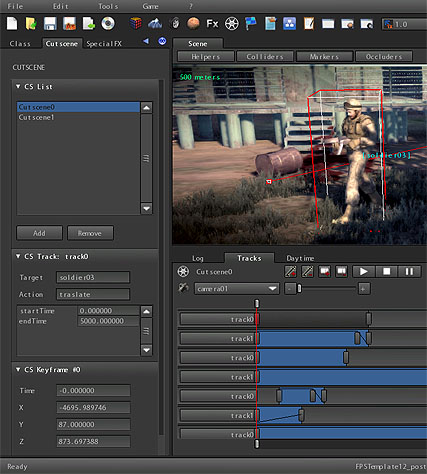
Starting From version 1.03.00 the new Cutscene edititng tools is available.
Using it you can create cinematic animated sequences perfectly integrated into the game flow.
Many params can be animated involving post processing effects just like Depth Of Field or color saturation and brightness , but also text fading, character animations, camera movements, music fading and many others...
Cinematic sequences can start when you want during the game flow. They can be triggered, for example, when player enters a volume, at the beginning of a game level and so on...
Cutscene sequences can be started by scripting or by using the new Event Handling system (see AI).

In the new S2 ENGINE HD the import of assets mainly concerns 3D models and animations.
The importing system is based on a generic interface to which specific importing modules are engaged, according to the extension of the file to import.
In essence it allows, potentially, to import resources of any file format, although for now, it was implemented only the module for importing COLLADA (DAE) files.
Since, in S2 ENGINE HD, COLLADA is the main form of assets importing it has been improved a lot compared to previous version in terms of compatibility and performance.
The choice of this format was due to its large spread between commercial and non-commercial modeling packages and the flexibility that allows you to import of all types of models compatible with S2 ENGINE, from the skeletal to simple meshes, and animations.
An important innovation over previous versions is the supprt for application authoring.
With a special command the Editor creates a folder with the name of the game to "publish": it places all DLLs, executables and an
In this way, with a simple click, you can protect all the resources made including scripts, textures, models, animations, sounds, etc... and obtain a "closed and compact" application.
